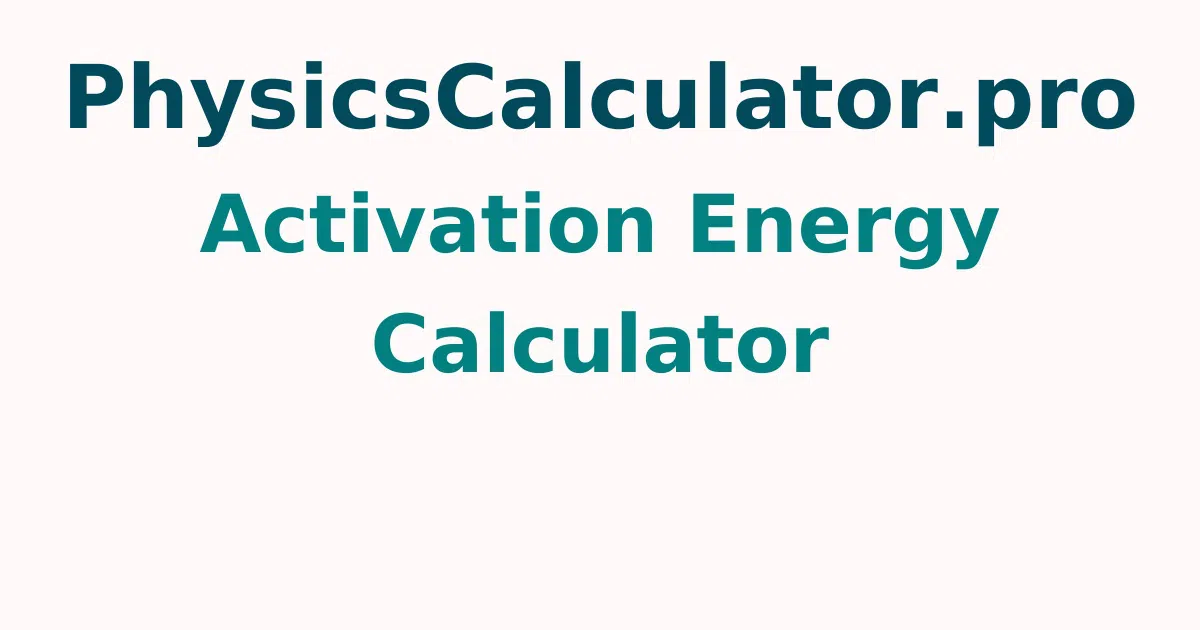Activation Energy Calculator
The activation energy calculator developed by us is also generally called the Arrhenius equation calculator, this calculator can help you calculate the minimum energy is required for a chemical reaction to happen in a stable equilibrium. Like, how much energy is required to light a candle, or maybe how much energy is required to burn a piece of wood.
What is Activation Energy?
Activation energy is the energy required for a chemical reaction to occur at the minimum temperature under stable conditions. This can be referred to as the threshold energy level; if you don't supply this amount of energy, the reaction will not take place in any condition made fit for it. Activation energy is required for all most all the types of reactions, for example, combustion.
For more concepts check out physicscalculatorpro.com to get quick answers by using this free tool.
Activation Energy Equation
You can find the activation energy for any reactant using the Arrhenius equation which is stated as follows Eₐ = -R * T * ln(k/A)
- where:
- R — Gas constant. It is equal to 8.314 J/(K•mol);
- T — Temperature of the surroundings, expressed in Kelvins;
- k — Reaction rate coefficient. It is measured in 1/sec and dependent on temperature;
- A — Pre-exponential factor (also called the frequency factor), also expressed in 1/sec. This coefficient does not vary with temperature and is constant for a reaction; and
- EΓéÉ — Activation energy of the reaction.
How to calculate the Activation Energy?
The following is how to use the moment of inertia calculator:
- Begin with measuring the temperature of the surroundings in which the reaction is taking place. For a general reaction, you can assume the room temperature (25 °C).
- Then further, choose your reaction and write down the frequency factor. For example, for reaction 2ClNO → 2Cl + 2NO, the frequency factor is equal to A = 9.4×109 1/sec, which means the frequency at which the product is being created under equilibrium.
- Choose the reaction rate coefficient for the given reaction and temperature, this can be scientifically determined or pre-known. And now Input all these values to our activation energy calculator. You will see that the calculator will find the activation energy very efficiently and effectively with few seconds.
Solved Examples on Activation Energy
Question 1: The rate of a reaction quadruples when the temperature changes from 290 to 330K. Find the energy of activation of the reaction assuming that it does not change with temperature.
Solution:
Given that:
The Temperature T1 = 290K
The Temperature T2 = 330K
The reaction constants K2 =4K1
Now, by substituting all the values we get,
The activation energy this required is Ea = 1,103276.8/40
= 27,581.9 J/mol
Hence Ea = 27.5819 kJ/mol
Question 2: Find out the activation energy, considering that k = 2.75 X10^-2Lmol Also, the pre-exponential factor here is 20M.
Solution:
Let R happens to be a gas constant whose value is 8.314 J/ molK, therefore
ln 2.75× 8.314j/molK400K = Ea (the activation energy)
Ea = 21.91 kJ/mol
Hence, the activation energy is 21.91 kJ/mol for this reaction.
FAQs on Activation Energy Calculator
1. What is the activation energy equation?
The activation energy for any reactant under suitable temperatures and conditions can be found using the Arrhenius equation. The formula is Ea = -R * T * ln(k/A). Here R is the gas constant, T is the temperature, k is the reaction rate coefficient, Ea is the activation energy of the reaction, and A is the pre-exponential factor.
2. How to find activation energy?
The activation energy of a reaction can be calculated using this method which states that the user should, Divide the reaction rate coefficient by the exponential factor and find the log of the value. Multiply it with the gas constant, temperature.
3. What happens at activation energy?
The activation energy for the forward reaction is the amount of free energy that must be added to go from the energy level of the reactants to the energy level of the transition state in any state before equilibrium is achieved.
4. Is activation energy zero or negative?
Although the energy changes that result from a reaction can be positive, negative, or even zero, before a reaction can occur, an energy barrier must be resolved in both situations.
5. Does the activation energy change with temperature?
As the temperature increases, the molecules move faster and therefore collide more frequently. The molecules also carry more kinetic energy.and hence this leads to the increase in the activation energy.
